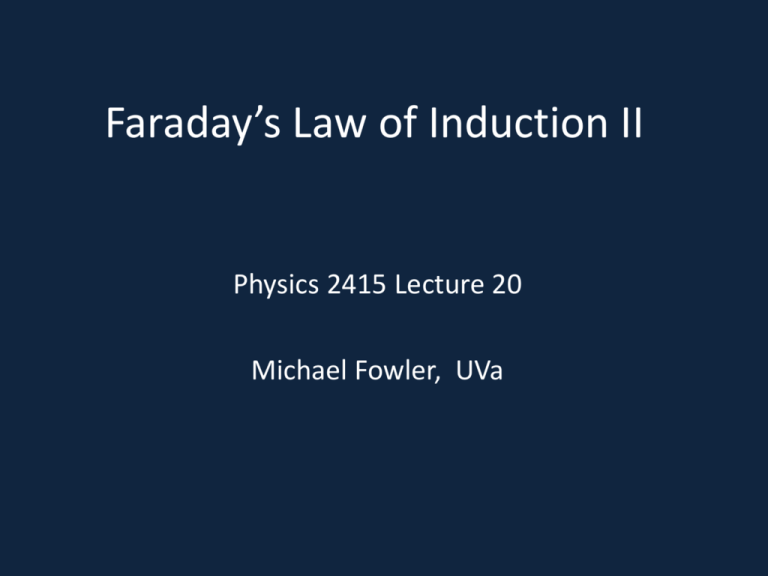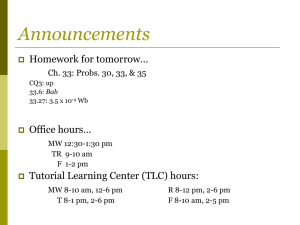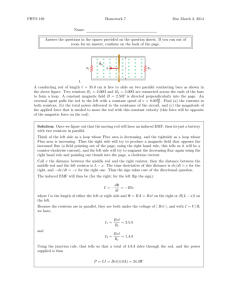Physics 1425: General Physics I
advertisement

Faraday’s Law of Induction II Physics 2415 Lecture 20 Michael Fowler, UVa Today’s Topics • • • • • Faraday’s Law of Induction Electric Generators Eddy Currents Electric Motors Transformers Magnetic Flux through a Loop • Recall Gauss’ theorem related flux of electric field through an area enclosing a volume to the charge inside. • Faraday introduced the concept of magnetic flux through a loop: the loop is “roofed” with a surface having the loop as boundary, the magnetic flux through the loop is B B dA • . dA B The integral is over the surface, adding contributions from tiny squares. Faraday’s Law of Induction • Faraday’s law of induction states that when the magnetic flux through a loop is changing, there is an induced emf in the loop given by: dB E dt • You get the sign of the emf from Lenz’s law… • . I N Magnet moving up S Lenz’s Law • The direction of the induced emf generated by a changing magnetic flux is always such as to oppose the motion. • Example: as the N pole moves up towards the loop, the current induced generates an N pole underneath to repel and slow down the approaching magnet. • . I N Magnet moving up S Lenz’s Law Continued… • The direction of the induced emf generated by a changing magnetic flux is always such as to oppose the change in flux through the loop. • Example: as the solenoid switches on, creating upward magnetic flux through the loop, the current generated in the loop will add downward flux. • . I Solenoid just switching on More on Lenz’s Law • Example: as the solenoid switches on, creating upward magnetic flux through the loop, the current generated in the loop will add downward flux. • This means there is considerable transient force on the loop! • . I Solenoid just switching on Electric Generators • The basic idea is to do work moving a conductor through a magnetic field, producing an emf, then provide a circuit so the emf can generate a current and therefore electrical energy. • . Copy of the first electric generator, constructed by Michael Faraday in 1831. A is the magnet; B, B’ the terminals. Electric Generators • The essential mechanism is a loop, or in practice a coil of many loops, rotating in a magnetic field, such as between the poles of a horseshoe magnet. • If the current is collected via slip rings (no commutator) it will be ac, for one loop: dB d E BA cos t BA sin t dt dt t is the angle betweenB and coil area vector A • . Loop has area A, rotates in field B at radians/sec. Back to Faraday’s Generator • If the disc is spinning anticlockwise, v B points inwards, so while the disc is rotating, an electric current is generated under and near the magnet flowing inwards to the axle, and round the external circuit. • . B v What happens if there is no external circuit? Eddy Currents • . • If we have an isolated rotating conducting disc, part between the poles of a magnet, the current generated in the magnetic field must find its way back: the circling currents are called eddy currents. • They look like the eddies for a boat going through water. Eddy Currents and Lenz’ Law • The magnet’s field is pointing • . downwards. • The eddy current before the magnet tries to minimize the field increase, that after the magnet tries to minimize the field decrease: in both cases, they oppose the motion. • Since the conductor has resistance to current flow, heat is generated: this can be eliminated by breaking the circuit—or used for cooking!








